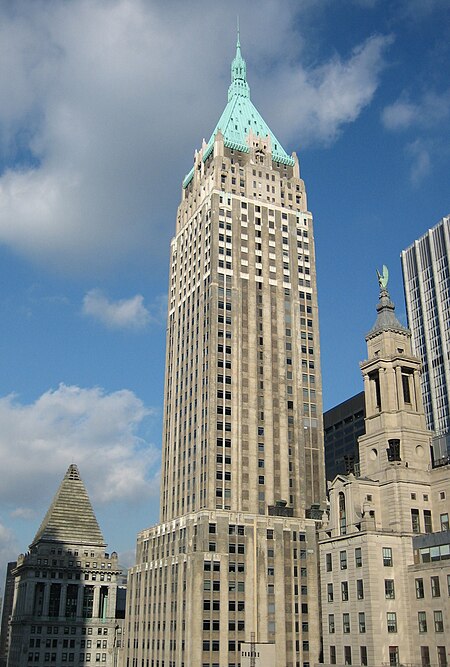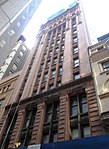40 Wall Street

40 Wall Street, also known as the Trump Building, is a 927-foot-tall (283 m) neo-Gothic skyscraper on Wall Street between Nassau and William streets in the Financial District of Manhattan in New York City. Erected in 1929–1930 as the headquarters of the Manhattan Company, the building was originally known as the Bank of Manhattan Trust Building, and also as the Manhattan Company Building, until its founding tenant merged to form the Chase Manhattan Bank. It was designed by H. Craig Severance with Yasuo Matsui and Shreve & Lamb. The building is on an L-shaped site. While the lower section has a facade of limestone, the upper stories incorporate a buff-brick facade and contain numerous setbacks. Other features of the facade include spandrels between the windows on each story, which are recessed behind the vertical piers on the facade. At the top of the building is a pyramid with a spire at its pinnacle. The Manhattan Company's main banking room and board room were on the lower floors, while the remaining stories were rented to tenants. The former banking room was converted into a Duane Reade store. Plans for 40 Wall Street were revealed in April 1929, with the Manhattan Company as the primary tenant, and the structure was completed in May 1930. 40 Wall Street and the Chrysler Building were competing for the distinction of world's tallest building at the time of both buildings' construction, though the Chrysler Building ultimately won that title. In its early years, 40 Wall Street suffered from low tenancy rates, as well as a plane crash in 1946. Ownership of the building and the land underneath it, as well as the leasehold on the building, has changed several times throughout its history. Since 1982, the building has been owned by two German companies. The leasehold was once held by interests on behalf of former Philippine president Ferdinand Marcos, though in 1995, a company controlled by developer and later U.S. president Donald Trump assumed the lease. The building was designated a city landmark by the New York City Landmarks Preservation Commission in 1995 and was added to the National Register of Historic Places (NRHP) in 2000. It is also a contributing property to the Wall Street Historic District, a NRHP district created in 2007.
Excerpt from the Wikipedia article 40 Wall Street (License: CC BY-SA 3.0, Authors, Images).40 Wall Street
Wall Street, New York Manhattan
Geographical coordinates (GPS) Address Website External links Nearby Places Show on map
Geographical coordinates (GPS)
| Latitude | Longitude |
|---|---|
| N 40.706964 ° | E -74.009672 ° |
Address
40 Wall Street (The Trump Building)
Wall Street 40
10005 New York, Manhattan
New York, United States
Open on Google Maps











